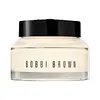What's inside
What's inside
 Key Ingredients
Key Ingredients

 Benefits
Benefits

 Concerns
Concerns

 Ingredients Side-by-side
Ingredients Side-by-side

Water
Skin ConditioningCyclopentasiloxane
EmollientBis-Diglyceryl Polyacyladipate-2
EmollientButylene Glycol
HumectantPPG-2 Myristyl Ether Propionate
EmollientCetyl Alcohol
EmollientPEG-40 Stearate
EmulsifyingButyrospermum Parkii Butter
Skin ConditioningSqualane
EmollientGlyceryl Stearate
EmollientSorbitan Stearate
EmulsifyingEpilobium Angustifolium Extract
Skin ConditioningYeast Extract
Skin ConditioningBeta-Carotene
Skin ConditioningSodium Hyaluronate
HumectantCitrus Grandis Peel Oil
MaskingTocopheryl Acetate
AntioxidantMethyl Glucose Sesquistearate
EmollientPelargonium Graveolens Flower Oil
MaskingDimethicone Crosspolymer
Emulsion StabilisingAcrylates/C10-30 Alkyl Acrylate Crosspolymer
Emulsion StabilisingCarbomer
Emulsion StabilisingPEG-20 Methyl Glucose Sesquistearate
EmulsifyingC12-15 Alkyl Ethylhexanoate
EmollientTetrasodium EDTA
Sodium Hydroxide
BufferingPanthenol
Skin ConditioningMagnesium Ascorbyl Phosphate
AntioxidantLimonene
PerfumingCitronellol
PerfumingGeraniol
PerfumingLinalool
PerfumingChlorphenesin
AntimicrobialPhenoxyethanol
PreservativeWater, Cyclopentasiloxane, Bis-Diglyceryl Polyacyladipate-2, Butylene Glycol, PPG-2 Myristyl Ether Propionate, Cetyl Alcohol, PEG-40 Stearate, Butyrospermum Parkii Butter, Squalane, Glyceryl Stearate, Sorbitan Stearate, Epilobium Angustifolium Extract, Yeast Extract, Beta-Carotene, Sodium Hyaluronate, Citrus Grandis Peel Oil, Tocopheryl Acetate, Methyl Glucose Sesquistearate, Pelargonium Graveolens Flower Oil, Dimethicone Crosspolymer, Acrylates/C10-30 Alkyl Acrylate Crosspolymer, Carbomer, PEG-20 Methyl Glucose Sesquistearate, C12-15 Alkyl Ethylhexanoate, Tetrasodium EDTA, Sodium Hydroxide, Panthenol, Magnesium Ascorbyl Phosphate, Limonene, Citronellol, Geraniol, Linalool, Chlorphenesin, Phenoxyethanol
Water
Skin ConditioningGlycerin
HumectantPetrolatum
EmollientTrisiloxane
Skin ConditioningLimnanthes Alba Seed Oil
Skin ConditioningCarthamus Tinctorius Seed Oil
MaskingPPG-2 Myristyl Ether Propionate
EmollientHydrogenated Polyisobutene
EmollientBeeswax
Emulsion StabilisingRosa Canina Fruit Oil
EmollientGluconolactone
Skin ConditioningC10-30 Cholesterol/Lanosterol Esters
EmulsifyingCetearyl Alcohol
EmollientCetearyl Glucoside
EmulsifyingDipropylene Glycol
HumectantAcrylates/C10-30 Alkyl Acrylate Crosspolymer
Emulsion StabilisingAllium Fistulosum Bulb Extract
Skin ConditioningAlteromonas Ferment Extract
Skin ConditioningArachidyl Glucoside
EmulsifyingArachidyl Alcohol
EmollientAvena Sativa Kernel Flour
AbrasiveBehenyl Alcohol
EmollientBisabolol
MaskingButylene Glycol
HumectantCalcium Gluconate
HumectantCarbomer
Emulsion StabilisingCeramide AP
Skin ConditioningCeramide EOP
Skin ConditioningCeramide NP
Skin ConditioningCetyl Alcohol
EmollientCholesterol
EmollientDisodium EDTA
Glyceryl Stearate
EmollientMagnesium Salicylate
PreservativeMagnesium Stearate
Cosmetic ColorantManganese Gluconate
Skin ConditioningMeadowfoam Estolide
Skin ConditioningNymphaea Alba Flower Extract
Skin ConditioningPEG-100 Stearate
Phenoxyethanol
PreservativePhytosphingosine
Skin ConditioningPyrus Malus Fruit Extract
Skin ConditioningSodium Benzoate
MaskingSodium Lauroyl Lactylate
EmulsifyingSodium Palmitoyl Proline
Skin ConditioningTriethanolamine
BufferingXanthan Gum
EmulsifyingZinc Stearate
Cosmetic ColorantWater, Glycerin, Petrolatum, Trisiloxane, Limnanthes Alba Seed Oil, Carthamus Tinctorius Seed Oil, PPG-2 Myristyl Ether Propionate, Hydrogenated Polyisobutene, Beeswax, Rosa Canina Fruit Oil, Gluconolactone, C10-30 Cholesterol/Lanosterol Esters, Cetearyl Alcohol, Cetearyl Glucoside, Dipropylene Glycol, Acrylates/C10-30 Alkyl Acrylate Crosspolymer, Allium Fistulosum Bulb Extract, Alteromonas Ferment Extract, Arachidyl Glucoside, Arachidyl Alcohol, Avena Sativa Kernel Flour, Behenyl Alcohol, Bisabolol, Butylene Glycol, Calcium Gluconate, Carbomer, Ceramide AP, Ceramide EOP, Ceramide NP, Cetyl Alcohol, Cholesterol, Disodium EDTA, Glyceryl Stearate, Magnesium Salicylate, Magnesium Stearate, Manganese Gluconate, Meadowfoam Estolide, Nymphaea Alba Flower Extract, PEG-100 Stearate, Phenoxyethanol, Phytosphingosine, Pyrus Malus Fruit Extract, Sodium Benzoate, Sodium Lauroyl Lactylate, Sodium Palmitoyl Proline, Triethanolamine, Xanthan Gum, Zinc Stearate
 Reviews
Reviews

Ingredients Explained
These ingredients are found in both products.
Ingredients higher up in an ingredient list are typically present in a larger amount.
Acrylates/C10-30 Alkyl Acrylate Crosspolymer is a synthetic polymer. It is used to thicken and improve the texture of products. Due to its properties, it can prevent water and oil ingredients from separating.
Butylene Glycol (or BG) is used within cosmetic products for a few different reasons:
Overall, Butylene Glycol is a safe and well-rounded ingredient that works well with other ingredients.
Though this ingredient works well with most skin types, some people with sensitive skin may experience a reaction such as allergic rashes, closed comedones, or itchiness.
Learn more about Butylene GlycolCarbomer is a polymer of acrylic acid. Its main role is to create a gel consistency.
A high amount of carbomer can cause pilling or balling up of products. Don't worry, most products contain 1% or less of carbomer.
Cetyl Alcohol is a fatty alcohol. Fatty Alcohols are most often used as an emollient or to thicken a product.
Its main roles are:
Though it has "alcohol" in the name, it is not related to denatured alcohol or ethyl alcohol.
The FDA allows products labeled "alcohol-free" to have fatty alcohols.
Learn more about Cetyl AlcoholGlyceryl Stearate is a mix of glycerin and stearic acid.
It is used to stabilize the mixing of water and oil ingredients. By preventing these ingredients from separating, it can help elongate shelf life. It can also help thicken the product's texture.
As an emollient, it helps soften skin and supports barrier-replenishing ingredients.
In cosmetics, Glyceryl Stearate is often made from vegetable oils or synthetically produced.
This ingredient may not be fungal-acne safe
Fun fact: The human body also creates Glyceryl Stearate naturally.
Learn more about Glyceryl StearatePhenoxyethanol is a preservative that has germicide, antimicrobial, and aromatic properties. Studies show that phenoxyethanol can prevent microbial growth. By itself, it has a scent that is similar to that of a rose.
It's often used in formulations along with Caprylyl Glycol to preserve the shelf life of products.
This ingredient comes from propionic acid (a preservative) and myristyl alcohol (a fatty alcohol).
It is an emollient that leaves a dry texture on the skin. According to a manufacturer, this ingredient is non-occlusive.
The 2 stands for the number of repeating units of propylene glycol in the compound.
Chem/IUPAC: Poly[oxy(methyl-1,2-ethanediyl)], .alpha.-(1-oxopropyl)-.omega.-(tetradecyloxy)-
Learn more about PPG-2 Myristyl Ether PropionateWater. It's the most common cosmetic ingredient of all. You'll usually see it at the top of ingredient lists, meaning that it makes up the largest part of the product.
So why is it so popular? Water most often acts as a solvent - this means that it helps dissolve other ingredients into the formulation.
You'll also recognize water as that liquid we all need to stay alive. If you see this, drink a glass of water. Stay hydrated!
Learn more about Water